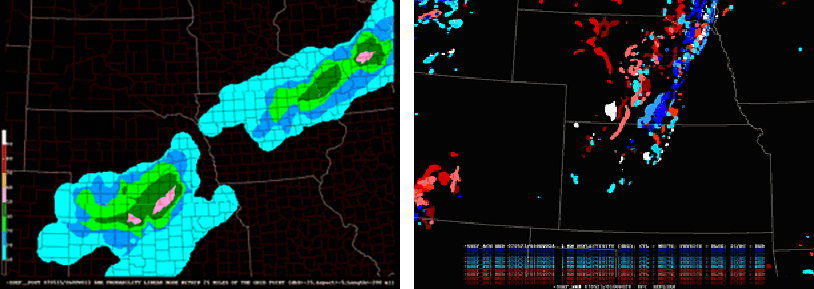EFP: 2007 Spring Experiment Summary
Working Hypotheses
- Numerical modelers can learn to incorporate more operational relevance in their research efforts if they work closely with forecasters in an experimental forecasting exercise.
- Operational forecasters can make more skillful interpretations of numerical model output if they work with numerical modelers in an experimental forecasting exercise.
Specific Objectives
Research Perspective
- To identify characteristic behaviors and specific strengths/weaknesses of the different WRF configurations and provide focused feedback to model developers on the performance of the experimental WRF models during severe thunderstorm episodes
- To evaluate the behavior of an ensemble of WRF model predictions of severe thunderstorms and explore the value added by the storm-scale ensemble versus deterministic WRF model predictions
Operational Perspective
- To evaluate the operational utility of several experimental versions of the WRF model and an ensemble of WRF model predictions during severe weather episodes
- To explore methods to incorporate storm-scale WRF model ensembles into the forecast process and to evaluate several ensemble forecast products
Preliminary Results
- A 4 km resolution ensemble forecasting system can forecast storm cell structures and predict low probability/high impact storm activities quite well. Some newly developed products derived from the ensemble of WRF predictions appeared to be quite effective at identifying areas favorable for severe thunderstorms; others appeared to require more investigation.
- Reflectivity calculation algorithm has big impact on ensemble evaluation. Microphysics scheme dependent algorithm should be used.
- WRF model predictions that had both initial condition perturbations and different representations of physical processes had more spread in the base state variables than WRF model predictions that had only different representations of physical processes.

Examples of new guidance products derived from the high resolution ensemble. At left, the figure shows the probability of a linear configuration of thunderstorms (e.g., a squall line), while the right side figure depicts the area covered by cores of simulated radar reflectivity (> 40 dBZ), color coded to represent the different ensemble members. [+]
Payoff
- The successful production and implementation of a storm-scale ensemble of WRF model forecasts into the forecast process has encouraged the meteorological community to explore the design and benefits of an ensemble of convection allowing model predictions.
- SPC forecasters are becoming skillful users of storm-scale models and severe-weather forecasters nationwide are becoming acquainted with and encouraged by storm-scale ensembles.
- 2007 Spring Experiment Summary (.pdf, 574 kB)
Related Publications
- Clark, A. J., W. A. Gallus, M. Xue, and F. Kong, 2009: A comparison of precipitation forecast skill between small convection-allowing and large convection-parameterizing ensembles. Wea. Forecasting, 24, 1121–1140.
- Clark, Adam J., William A. Gallus, Ming Xue, Fanyou Kong, 2010: Growth of Spread in Convection-Allowing and Convection-Parameterizing Ensembles. Wea. Forecasting, 25, 594–612.
- Clark, Adam J., William A. Gallus, Ming Xue, Fanyou Kong, 2010: Convection-Allowing and Convection-Parameterizing Ensemble Forecasts of a Mesoscale Convective Vortex and Associated Severe Weather Environment. Wea. Forecasting, 25, 1052–1081.
- Coniglio, M. C., J. S. Kain, S. J. Weiss, D. R. Bright, J. J. Levit, M. Xue, M. L. Weisman, Z. I. Janjic, M. Pyle, J. Du, and D. Stensrud, 2007: Evaluating WRF model output for severe-weather forecasting: The 2007 NOAA HWT Spring Experiment. Preprints, 22th Conference on Weather Analysis and Forecasting/18th Conference on Numerical Weather Prediction, Park City, UT, Amer. Meteor. Soc., CD-ROM, 11A.2.
- Coniglio, M.C., J. S. Kain, S. J. Weiss, M. Xue, M. L. Weisman, and Z. I. Janjic, 2007: Evaluating storm-scale model output for severe-weather forecasting: The 2007 NOAA HWT Spring Experiment. Preprints, 4th European Conference on Severe Storms, The International Centre for Theoretical Physics, Trieste, Italy, CD-ROM, 03.11.
- Kong, F., M. Xue, D. R. Bright, M. C. Coniglio, K. W. Thomas, Y. Wang, D. Weber, J. S. Kain, S. J. Weiss, and J. Du, 2007: Preliminary analysis on the real-time storm-scale ensemble forecasts produced as a part of the NOAA Hazardous Weather Testbed 2007 Spring Experiment. Preprints, 22th Conference on Weather Analysis and Forecasting/18th Conference on Numerical Weather Prediction, Park City, UT, Amer. Meteor. Soc., CD-ROM, 3B.2.
- Schwartz, C. S., J. S. Kain, S. J. Weiss, M. Xue, D. R. Bright, F. Kong, K. W. Thomas, J. J. Levit, M. C. Coniglio, 2009: Next-day convection-allowing WRF model guidance: A second look at 2 vs. 4 km grid spacing. Mon. Wea. Rev., 137, 3351–3372.
- Schwartz, C. S., J. S. Kain, S. J. Weiss, M. Xue, D. R. Bright, F. Kong, K. W. Thomas, J. J. Levit, M. C. Coniglio, M. S. Wandishin, 2009: Toward improved convection-allowing ensembles: Model physics sensitivities and optimizing probabilistic guidance with small ensemble membership. Wea. Forecasting, 25, 263–280.
- Schwartz, C. S., J. S. Kain, S. J. Weiss, M. Xue, D. R. Bright, F. Kong, K. W. Thomas, J. J. Levit, M. C. Coniglio, M. S. Wandishin, 2010: Toward improved convection-allowing ensembles: Model physics sensitivities and optimizing probabilistic guidance with small ensemble membership. Wea. Forecasting, 25, 263–280.
- Xue, M., F. Kong, D. Weber, K. W. Thomas, Y. Wang, K. Brewster, K. K. Droegemeier, J. S. Kain, S. J. Weiss, D. R. Bright, M. S. Wandishin, M. C. Coniglio, and J. Du, 2007: CAPS realtime storm-scale ensemble and high-resolution forecasts as part of the NOAA Hazardous Weather Testbed 2007 Spring Experiment. Preprints, 22th Conference on Weather Analysis and Forecasting/18th Conference on Numerical Weather Prediction, Park City, UT, Amer. Meteor. Soc., CD-ROM, 3B.1.

